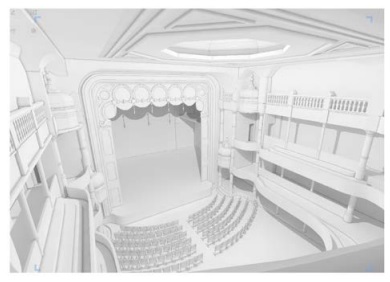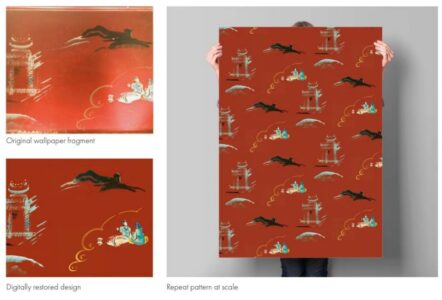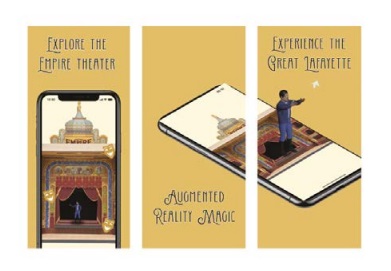Stuart Smith-Gordon has worked as an interior and exhibition designer for the last 15 years in and for organisations including Studioarc Design Consultants, National Museums Scotland, Aberdeen Art Gallery, National Galleries, Imperial War Museum and National Trust for Scotland.
During lockdown in 2020, whilst theatres across the world were shuttered, Stuart decided to progress his existing business, Ice Cream at the Interval – which, up until that point, had been focused on illustrating and paper engineering model theatres with a proportion of sales going back to theatre charities – into connecting a variety of data sets which existed within the theatre buildings he had previously explored.
Describing theatre as “mini art galleries and museums [that] contain incredible friezes, plaster casts, textile design, timber crafts and metal crafts, mosaics”, Stuart felt that such work, which existed in the fragmented form of photographs, architectural plans and individual as well as cultural memories, should be brought together in a more connected and interactive form, to open up these spaces and their history to current and future audiences.
Stuart applied to Creative Informatics to be part of the Connected Innovators programme, with a proposal to bring back to life Edinburgh’s Empire Palace Theatre which was lost to fire in 1911. With only a small number of photographs remaining of this incredible building, further data research was needed to piece together the many missing puzzle pieces to create a complete model of the auditorium and stage.

Image: 3D render of Empire Theatre auditorium. Source: Ice Cream at the Interval
By digitising and redrawing plans, data relating to the Empire Theatre would be preserved for another generation and highlight significant built heritage. The research and development undertaken would then translated into a fully coloured version of the theatre as a wooden slot together model, which would come to life with the use of AR, animating Topsy in Toyland which was performed on the Empire’s stage in 1894, as well as allowing close, interactive exploration of all the data collected.
As archive material was gathered to create the project’s core dataset, it became apparent that much of the material was of a fragile nature, which required Stuart to use his significant design skills to digitally restore a collection of assets which included architectural plans, wallpaper samples, and colourising black & white photographs, as well as creating a 3D model of the theatre from the materials, which offers new and different viewpoints around the auditorium, and a more thorough understanding of the building’s presentation and functionality.

Image: Digitally restored wallpaper design. Source: Ice Cream at the Interval
Having been connected to another Creative Informatics partner, SENSECity, by the CI team, Stuart was able to benefit from their considerable experience in developing AR products. Working with one of their designers following the completion of a prototype physical model, an AR app was developed which includes a homepage, instruction page, animations, a short performance and interactive hotspots for the user to explore. Further potential exists to expand the app in the future, as the prototype has proved very successful with test audiences.


Image: Screenshots of the Empire Theatre Augmented Reality app. Source: Ice Cream at the Interval
As well as a series of physical models being available for purchase online, Stuart has shared his expanded AR work in a series of talks – one to a virtual audience of 70 individuals including architectural historians, special interest groups and members of the public. He was also invited by Capital Theatres to speak to their members and audiences at a very successful event in May 2023, at the Festival Theatre, the site on which the Empire Theatre once stood, bringing the project full circle, and back onto its home ground with life and dynamism once more.
Additionally, Stuart has been featured in a National Galleries podcast about historical theatre sites within Edinburgh, is collaborating with SENSECity on a similar physical model with digital AR for Brighton Dome, and has significantly expanded both his skills and network of theatre professionals and historians, both of which will help him continue to develop his practice and progress the next iteration of his product.
“Being part of the Connected Innovators has been hugely beneficial for me. It has opened me up to other innovators who have been able to share knowledge including relevant links or resources to access. With most projects there is a deadline and little time to experiment and grow. This funding has allowed me time to explore a project further and push creatively what I can achieve” – Stuart Smith-Gordon

